Ofunne Azinge is a Nigerian artist based in the UK. She was born in Nigeria and moved to England at the age of five. Her large-scale paintings combine portraits in a mixture of black/blue/purple hues with image transfers to create scenes that feature objects that are culturally significant to her. She draws on aspects of her life including the socio-political effects of migration, nostalgia, and the complexities of her upbringing. She graduated with a BA (Hons) Fine Art from Leeds Arts University in 2021 and is currently at Manchester Met doing an MA Painting.
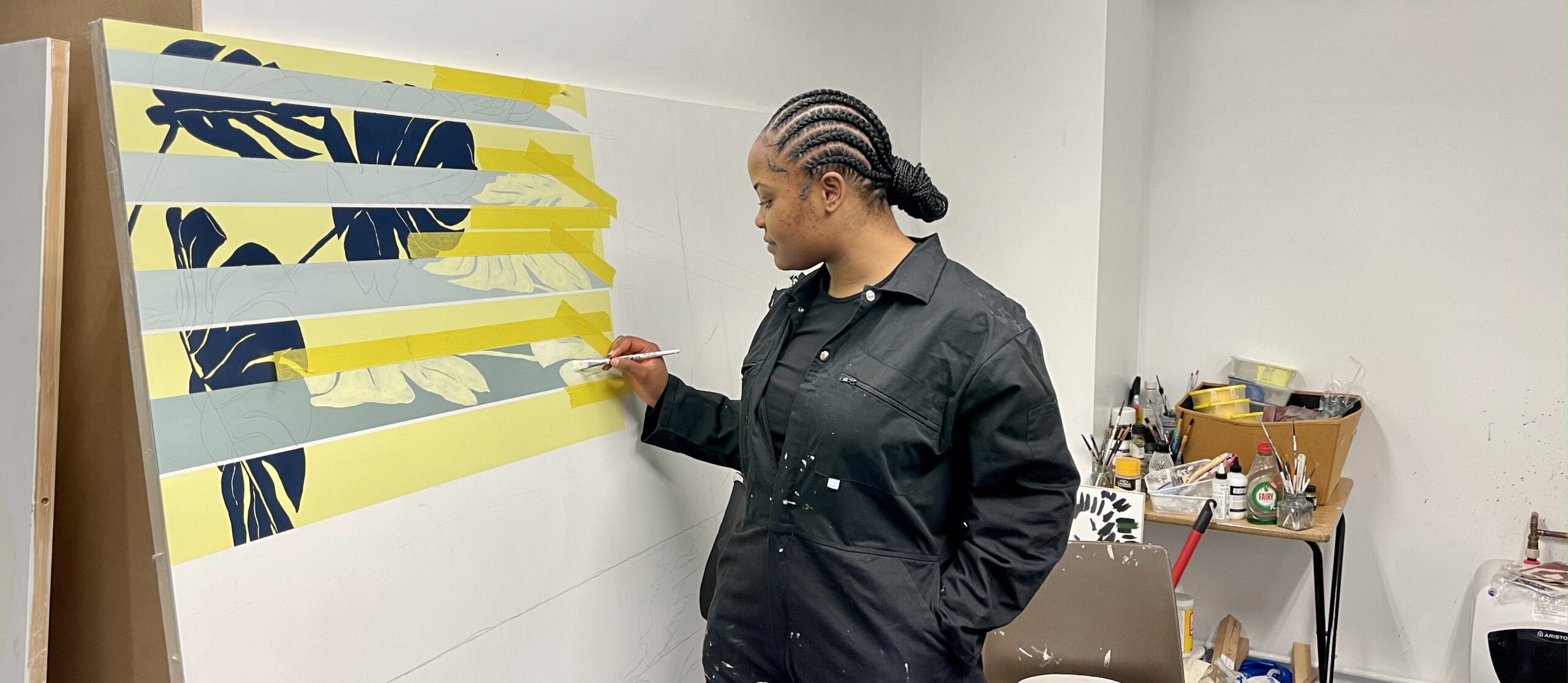
Ofunne painting in her studio.
Court: Thanks for having me over to your studio. I hadn’t realised Manchester Met had the building that use to be Cornerhouse. Do you live nearby?
Ofunne: Thank you for coming down. I do actually, I’m a four-minute walk away – so no excuse not to show up to lectures! This is pretty much my second home. I aim to spend as much time here as possible because it’s not open 24 hours a day. Sometimes I just come here to think – it’s my sanctuary.
Court: So you moved from Nigeria to South East London when you were five. Can you tell me a bit about your experience of moving between the two?
Ofunne: Whilst in Nigeria I mostly lived with my grandparents in Lagos and spent some time with my dad and aunts. Then when I was five, I moved to London with my mum. I did all of primary school in Southeast London and then moved back to Nigeria and spent three years at boarding school. I came back to London in year 10 where I lived with family friends and then moved to Lincoln, for A levels where I lived with a pastor and her family before moving to Leeds for university.
At the time it felt very unstable. I changed schools quite a bit: I would make friends and then had to leave. Sometimes I struggled to adapt and by the time I did, it was time to go. And not all of those living experiences where the best. Now that I’m older and in my own space, I can appreciate those experiences allowed me to embrace different traditions, languages, cultures and generations.
Court: Yeah, you grew up not only negotiating new cultures but also different dynamics across households. You also mentioned that you used a western name and only went back to Ofunne when you enrolled at Leeds Art University. Do you feel your work is a way to explore and express aspects of your identity?
Ofunne: In my earlier work, definitely. Before I started LAU, I had just completed therapy and my mental health was the best it had been in a long time. I wanted to focus on figuring out who I was and my name was part of that. When I moved to England when I was five, I renamed myself Valerie to try to help me fit in but now I use Ofunne.
In my earlier photography and film work I was heavily inspired by drag culture and used make-up and costumes to depict different aspects of my identity. With my current work I’m very interested in the layers and complexities of other people’s identities but also merging it with mine.
Court: Did you always want to be an artist?
Ofunne: I’ve been drawing since I could hold a pencil. Art has always been the one thing that I’ve been sure of. In year five we had a philosopher speak to the class. We all sat in a circle, and he showed two images of artworks. One with pale pastel pink tones and the other with bold renaissance colours. He then asked us which painting we thought was more “beautiful”. The first person said the pink one and then everyone proceeded to agree. When asked I said the other painting, because it was “stronger” and everyone laughed, because how could a painting be strong? I didn’t realise it at the time but that was the moment I knew I was going to be an artist!
I just didn’t have the words or knowledge to articulate it at the time but I knew I was onto something, and it would take almost nine years before getting into art school where it finally made sense. Funnily enough, everyone I’ve met from primary school and told I’m now an artist has responded with “I always knew it!”
Court: Do you come from a creative background?
Ofunne: Not at all. I come from a family of lawyers, barristers, doctors, engineers and accountants – the Nigerian dream! I’m the only artist in my family. I’d say my dad was very creative, he was very eccentric and stood out from the rest of his siblings, so I probably got it from him.
Court: I read that you started a degree in art and then studied law before going back to art. Can you talk us through that?
Ofunne: I started university too early. Mentally I wasn’t prepared. I was elated to get into a Russel Group university to study fine art, but it was very research based, so less time on actually painting and not a lot of support or 1-1 with teachers. I didn’t understand why I wasn’t doing well and figured maybe art wasn’t for me and it was time to be serious, so I switched to law. Law was tough but I enjoyed it, though I had no passion for it and knew it wasn’t the career I wanted. I mentioned earlier about being in therapy – I didn’t want to waste time doing things I didn’t enjoy. So, I switched back to fine art, this time at a university that was perfect for me and suddenly everything made sense.
Court: At uni did you experiment with other mediums or were you always drawn to painting?
Ofunne: I started painting in first year but I like to take my time and university required me to work quickly to submit work so for the next two years I experimented with film, photography, 3D digital art, 3D printing, clay and screen-printing. I learnt so much about myself and what was important to me and my practice. And then I start painting again in my final year with all this additional experience and it just felt right.
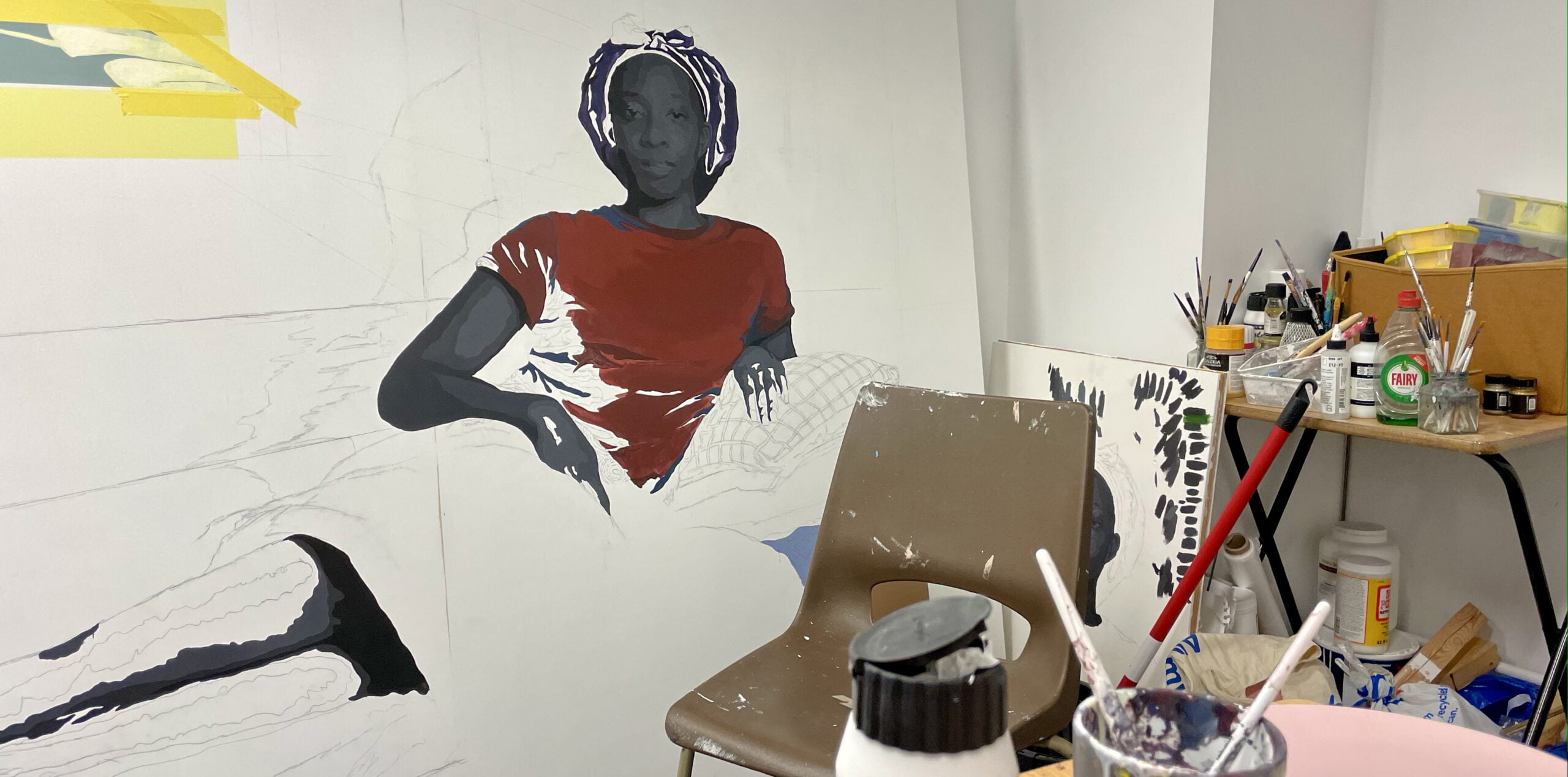
Work in progress.
Court: You paint the figures exclusively using black, blues and purples without white. How did this come about?
Ofunne: I came across a book on DADA but specifically the response from black artists. In this, a lecturer encouraged her students to question why we begin our paintings/sketches with white. For example, the surface of primed canvases are white and our sketchbook pages are white. They were supposed to approach this theoretically in the sense that a lot of our systems are built on European constitutions. By removing white they would change their colour choices and perhaps their practice all together. I can’t find the source anywhere, but it stuck with me, and I always wanted to include it in my practise somehow. So now when I paint my figures, I paint with the absence of white. I restrict my palette to black, blue, brown, beige and sometimes I also use purple.
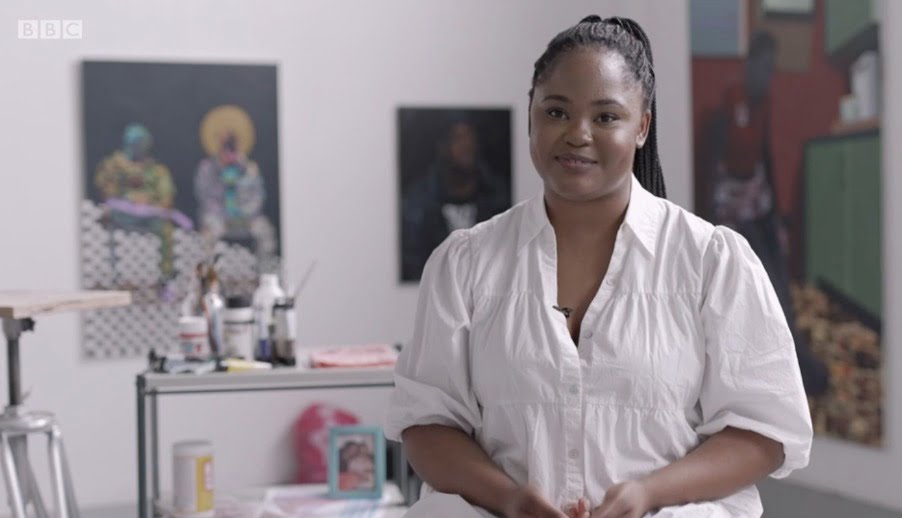
Ofunne in her studio at LAU for the BBC coverage of the 2021 Royal Academy Summer Exhibition. (Credit: BBC)
Court: Congrats on having work selected for the Royal Academy Summer Exhibition and for being featured on the BBC coverage of the exhibition. Can you tell us about that experience?
Ofunne: Thank you! It’s been extremely exciting and career changing! I applied for the exhibition because of the theme [Reclaiming Magic] and because it was being coordinated by Yinka Shonibare, who I really admire. There are two stages to the application process and I was shortlisted for the second round, which meant I could bring the pieces to London for the judges. It was at this point that the BBC got in contact and I knew this was big! It was all very unexpected but came at the perfect time. They came to my studio in Leeds and filmed the whole process. I loved every moment.
In addition to the documentary and having one of my pieces open the show – which I was told is unprecedented – I was selected by Yinka Shonibare as one of his “Curators Choice”, which put me in a list of 50 or so artists whose work he particularly favoured in the exhibition. To have my name amongst those great artists is something I will always cherish, and I can view on the RA website forever. I also won “The Arts Club” award. So I can definitely say I gained everything from this.
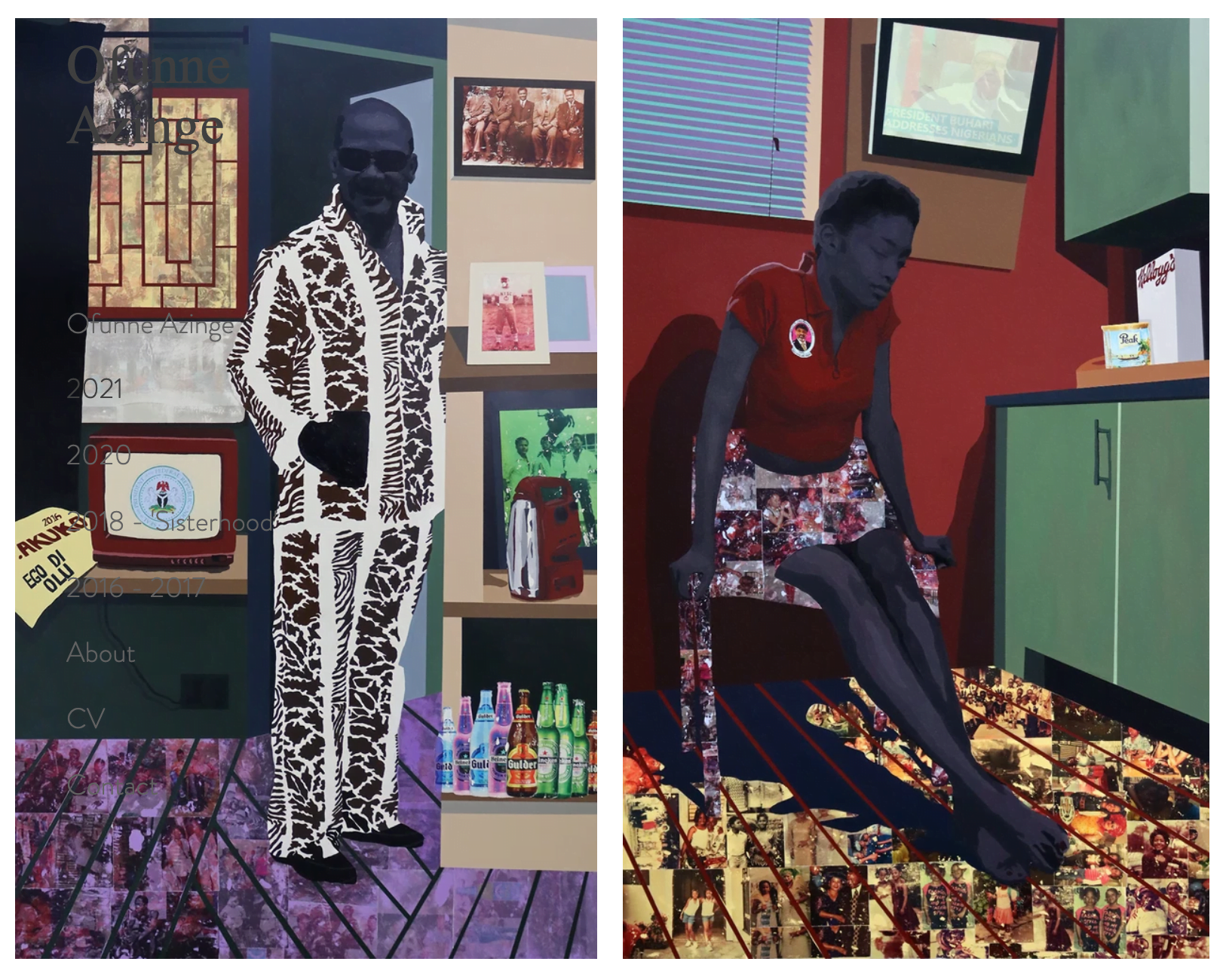
Ije ego di olu (to look for money is hard) and dis wan na clone.
Court: The two pieces in the show lje ego di olu (to look for money is hard) and dis wan na clone are painted in the same style but have such a different energy about them. Can you talk us through the paintings and who these figures are?
Ofunne: I painted both during the second lockdown. I was alone in my university accommodation, a small, dimly lit room, with very large works that took over the space. I was missing home so both paintings are fuelled by nostalgia.
dis wan na clone is a self-portrait without self. I photographed my friend Bimpe who is a professional model but I captured a very natural moment. Peak milk and cornflakes are staples in every middle-class Nigerian home, and reference my two identities, Nigerian and British. The photographs used in the image transfers are of family and friends, and depicted on the TV is a speech being given that relates to Nigerians protesting against police brutality. During these protests the president remained quiet and people questioned if he was even alive. When he finally gave a speech people were suspicious and thought it could be an actor, hence the title dis wan na clone.
Ije ego di olu is in honour of my late father and the men who raised me. I really wanted to celebrate him and honour his livelihood – he was a bank manager. I also reference a period of stagflation in Nigeria in which millions of Nigerians including my father lost their jobs. I was in private boarding school but had to leave for a few months as no one could afford my tuition. What I love about this painting is that it represents the spirit of Nigerians. Even in the face of turmoil, they continue to celebrate!

dis wan na clone in the BBC coverage of the 2021 Royal Academy Summer Exhibition. (Credit: BBC)
Court: I generally ask everyone what their career highlight to date is, but I think I can guess what your answer will be!
Ofunne: Definitely exhibiting in the Royal Academy of Arts!
Court: And do you have a dream project that you would love to see happen?
Ofunne: I’d love to have a solo show in London, I’d also love for my work to be part of a permanent public collection somewhere notable, and it would be pretty cool to paint a magazine cover someday. Other than that, exhibiting internationally is a goal and having the public experience my work.
Court: Are the paintings you’re working on at the moment for specific exhibitions?
Ofunne: Yes, they are! I have two exhibitions coming up in London, both opening on the 3 March and both are really close to each other, one is with Gillian Jason Gallery and the other is at Pi Artworks. Both are group shows with some phenomenal artists and I’m looking forward to them.
Court: Thank you so much. It’s been fab to meet you and get to see your work in progress and I cannot wait to see these when they’re on show in London.
Filed under: Art & Photography
Tagged with: artist, court Spencer, exhibition, fine art, leeds, leeds artist, Leeds arts university, nigeria, painting, Royal Academy, snooping through studios, Studio
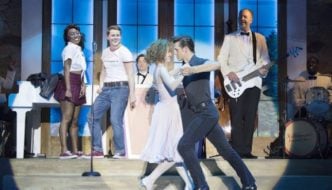
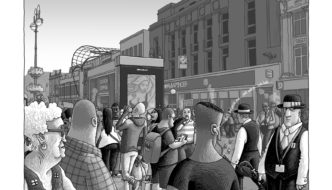

Comments